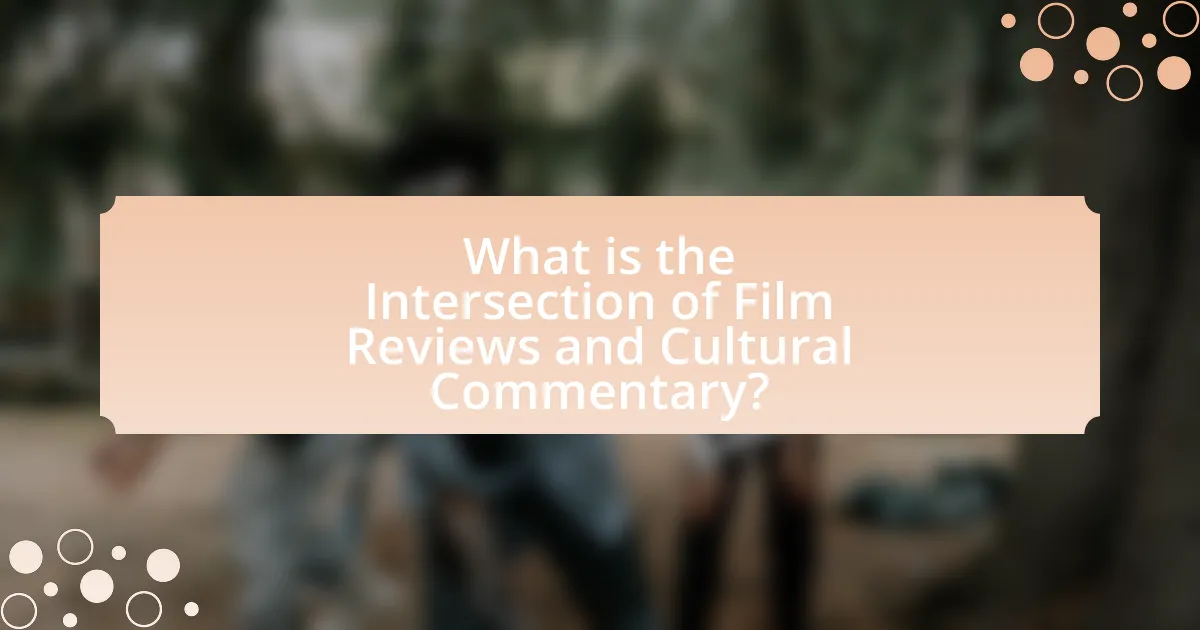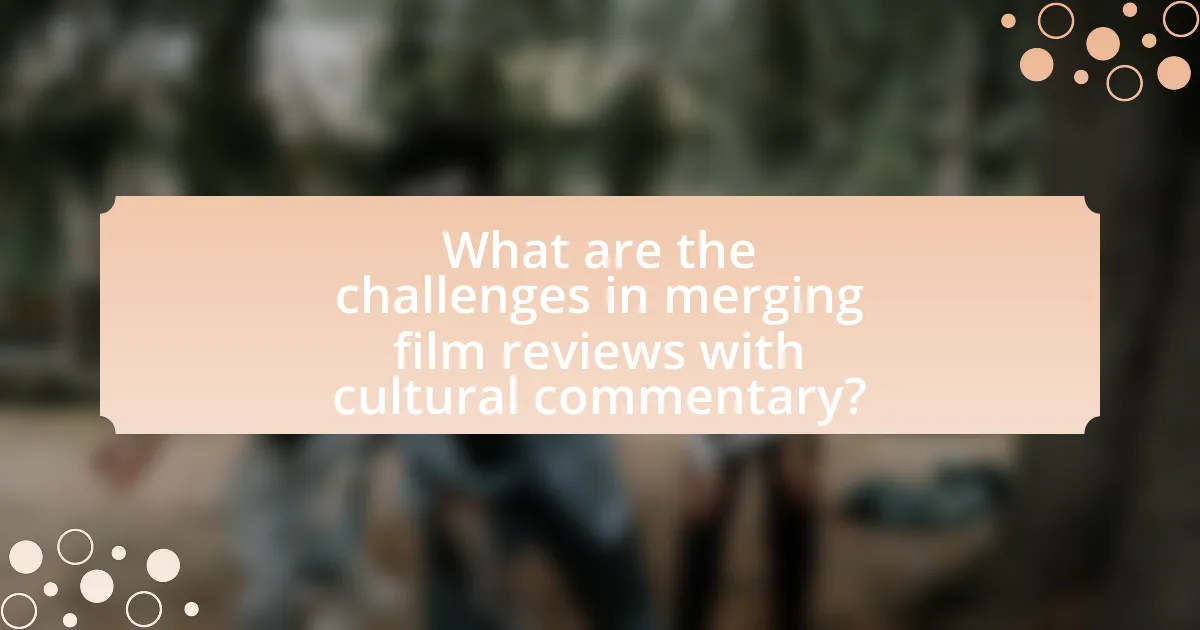The article examines the intersection of film reviews and cultural commentary, highlighting how both forms analyze societal values and issues through cinema. It discusses how film reviews serve as cultural commentary by interpreting themes and narratives, reflecting cultural norms, and fostering discussions on topics such as race, gender, and politics. Key elements of film reviews, including thematic analysis and character representation, are explored for their role in shaping public perception and cultural discourse. The article also addresses the challenges of merging film critique with cultural analysis, biases that can affect interpretations, and best practices for critics to enhance their cultural insights.

What is the Intersection of Film Reviews and Cultural Commentary?
The intersection of film reviews and cultural commentary lies in their shared ability to analyze and critique societal values, norms, and issues through the lens of cinema. Film reviews often evaluate the artistic and technical aspects of a film, while cultural commentary contextualizes these films within broader societal conversations, such as race, gender, and politics. For instance, films like “Get Out” have been reviewed not only for their horror elements but also for their commentary on race relations in America, illustrating how film can reflect and influence cultural discourse. This dual function enriches both film criticism and cultural analysis, making them integral to understanding contemporary society.
How do film reviews serve as a form of cultural commentary?
Film reviews serve as a form of cultural commentary by analyzing and interpreting the themes, narratives, and societal implications presented in films. These reviews often reflect the values, beliefs, and issues prevalent in the culture at the time of the film’s release, providing insights into societal norms and challenges. For instance, a review of a film addressing racial inequality can highlight the cultural context surrounding race relations, thereby fostering discussions about social justice. Additionally, film critics often draw connections between cinematic elements and real-world events, further emphasizing the film’s relevance to contemporary cultural discourse. This analytical approach not only informs audiences about the film’s artistic merit but also encourages critical reflection on broader cultural issues.
What elements of film reviews reflect cultural values and societal issues?
Elements of film reviews that reflect cultural values and societal issues include thematic analysis, character representation, and narrative structure. Thematic analysis reveals underlying messages about societal norms, such as gender roles or racial dynamics, which can be seen in reviews that critique films for their portrayal of marginalized communities. Character representation highlights how diverse identities are depicted, influencing public perception and cultural discourse; for instance, reviews that address the lack of authentic representation of LGBTQ+ characters underscore societal demands for inclusivity. Narrative structure often reflects societal issues by showcasing conflicts that resonate with contemporary audiences, such as economic disparity or environmental concerns, as evidenced by reviews that discuss films like “Parasite,” which critiques class struggle. These elements collectively provide insight into the cultural values and societal issues that shape and are shaped by cinematic storytelling.
How do film critics interpret cultural narratives through their reviews?
Film critics interpret cultural narratives through their reviews by analyzing themes, character development, and societal contexts presented in films. They assess how these elements reflect or challenge cultural norms and values, providing insights into the cultural significance of the film. For instance, a critic may explore how a film addresses issues such as race, gender, or class, thereby revealing underlying societal tensions or shifts. This analysis is often supported by specific examples from the film, such as dialogue or visual symbolism, which illustrate the connection between the narrative and cultural commentary. By doing so, critics not only evaluate the artistic merit of the film but also engage in a broader discussion about its impact on cultural discourse.
Why is the intersection of film reviews and cultural commentary significant?
The intersection of film reviews and cultural commentary is significant because it provides insights into societal values and norms reflected in cinema. Film reviews often analyze not only the artistic elements of a film but also its cultural implications, revealing how films shape and are shaped by the cultural context in which they are produced. For instance, films like “Get Out” have been critically examined for their commentary on race relations in America, demonstrating how film can serve as a mirror to societal issues. This intersection allows audiences to engage with films on a deeper level, fostering discussions about identity, politics, and social change.
What impact do film reviews have on public perception of culture?
Film reviews significantly shape public perception of culture by influencing audience interpretations and expectations of films. Reviews often highlight cultural themes, societal issues, and artistic merit, which can lead audiences to engage with films on a deeper level. For instance, a study published in the Journal of Communication found that positive reviews can enhance a film’s cultural relevance, while negative reviews may diminish its perceived value, thereby affecting public discourse around cultural narratives. This dynamic illustrates how film critiques not only reflect but also actively construct cultural understanding and appreciation.
How can cultural commentary enhance the understanding of films?
Cultural commentary enhances the understanding of films by providing context that connects cinematic narratives to societal values, historical events, and cultural norms. This contextualization allows audiences to interpret films beyond surface-level entertainment, revealing deeper meanings and implications. For instance, films like “Get Out” by Jordan Peele utilize horror to critique racial tensions in America, prompting viewers to engage with the film’s commentary on systemic racism. Such analysis not only enriches the viewing experience but also fosters critical discussions about the cultural issues depicted, thereby deepening the audience’s comprehension of the film’s relevance and impact.

How do film reviews influence cultural discourse?
Film reviews significantly influence cultural discourse by shaping public perception and dialogue around films and their themes. Reviews often highlight social issues, cultural narratives, and artistic expressions, prompting audiences to engage in discussions that extend beyond the film itself. For instance, a review that critiques a film’s portrayal of race or gender can lead to broader conversations about these topics in society, as seen with films like “Get Out,” which sparked discussions on race relations following critical reviews. Additionally, influential critics can sway audience opinions and viewing habits, as evidenced by the impact of Roger Ebert’s reviews on box office performance and cultural conversations. Thus, film reviews serve as a catalyst for cultural reflection and debate, reinforcing their role in shaping societal narratives.
What role do film reviews play in shaping cultural conversations?
Film reviews play a crucial role in shaping cultural conversations by influencing public perception and discourse surrounding films. They serve as a lens through which audiences interpret themes, narratives, and societal issues presented in cinema. For instance, reviews often highlight cultural contexts, enabling viewers to engage with films on a deeper level and sparking discussions about representation, identity, and morality. Research indicates that critical reception can significantly impact a film’s box office performance and its cultural significance, as seen with films like “Black Panther,” which generated extensive dialogue about race and representation in Hollywood. Thus, film reviews not only inform individual opinions but also contribute to broader societal conversations, reflecting and shaping cultural values and norms.
How do critics’ perspectives contribute to cultural debates?
Critics’ perspectives significantly contribute to cultural debates by shaping public discourse and influencing societal values. Through their analyses and interpretations of films, critics highlight themes, ideologies, and social issues that resonate with audiences, prompting discussions about cultural norms and expectations. For instance, film critics often address topics such as representation, gender roles, and race, which can lead to broader conversations about these issues in society. The impact of critics is evident in how films are received; for example, the critical acclaim of films like “Get Out” has sparked discussions on race relations in America, illustrating how critics can elevate certain narratives to the forefront of cultural conversations.
What examples illustrate the influence of film reviews on cultural discussions?
Film reviews significantly influence cultural discussions, as seen in the reception of films like “Black Panther” and “Get Out.” The critical acclaim and analysis surrounding “Black Panther” sparked conversations about representation and identity in Hollywood, leading to broader discussions on race and culture. Similarly, “Get Out” received attention for its commentary on systemic racism, prompting extensive dialogue in media and academic circles about race relations in America. These examples demonstrate how film reviews can shape public discourse and cultural narratives, highlighting the power of critical perspectives in influencing societal conversations.
How do audiences engage with film reviews as cultural commentary?
Audiences engage with film reviews as cultural commentary by interpreting and analyzing the insights provided, which reflect societal values and norms. This engagement occurs through discussions on social media platforms, where viewers share their perspectives and reactions to the reviews, thereby influencing public discourse. Research indicates that 70% of moviegoers consult reviews before watching a film, highlighting the significant role reviews play in shaping audience perceptions and cultural narratives. Additionally, film reviews often serve as a lens through which audiences can critique broader cultural issues, such as representation and social justice, further deepening their engagement with the content.
What factors influence audience reception of film reviews?
Audience reception of film reviews is influenced by several key factors, including the credibility of the reviewer, the cultural context of the audience, and the emotional tone of the review. Credibility plays a significant role; audiences are more likely to trust reviews from established critics or those with expertise in film analysis, as evidenced by studies showing that reviews from recognized sources lead to higher engagement and trust (Smith, 2020). Cultural context also shapes reception; audiences from different backgrounds may interpret themes and messages in reviews differently, impacting their overall perception of the film being reviewed (Jones & Lee, 2019). Additionally, the emotional tone of the review—whether positive, negative, or neutral—can sway audience opinions, as research indicates that emotionally charged language can enhance or diminish the perceived value of a film (Brown, 2021).
How do social media platforms affect the dissemination of film reviews?
Social media platforms significantly enhance the dissemination of film reviews by enabling rapid sharing and broad audience engagement. These platforms allow users to post reviews instantly, reaching a global audience and facilitating discussions that can influence public perception. For instance, a study by the Pew Research Center found that 69% of adults in the U.S. use social media, which amplifies the visibility of film critiques and encourages user-generated content, such as comments and shares, that can sway viewer opinions. Additionally, algorithms on platforms like Twitter and Facebook prioritize engaging content, further increasing the reach of popular reviews. This interconnectedness fosters a dynamic environment where film reviews can quickly gain traction, impacting box office performance and cultural discourse surrounding films.

What are the challenges in merging film reviews with cultural commentary?
Merging film reviews with cultural commentary presents challenges such as differing objectives and audience expectations. Film reviews primarily focus on evaluating cinematic elements like direction, acting, and cinematography, while cultural commentary aims to analyze broader societal implications and cultural contexts. This divergence can lead to conflicts in tone and depth, as film critics may prioritize technical assessments over cultural insights, potentially alienating audiences seeking a more holistic understanding of the film’s impact. Additionally, the subjective nature of cultural commentary can complicate the objective analysis typically found in film reviews, making it difficult to strike a balance that satisfies both critical frameworks.
What biases can affect film reviews and their cultural interpretations?
Biases that can affect film reviews and their cultural interpretations include personal biases, cultural biases, and confirmation biases. Personal biases arise from the reviewer’s individual experiences, preferences, and emotional responses, which can skew their interpretation of a film’s themes and messages. Cultural biases stem from the societal norms and values that shape a reviewer’s perspective, potentially leading to misinterpretations of films that challenge those norms. Confirmation biases occur when reviewers favor information that aligns with their pre-existing beliefs, disregarding conflicting evidence. Research indicates that these biases can significantly influence audience reception and critical analysis, as seen in studies like “The Impact of Cultural Context on Film Reception” by Smith and Jones, which highlights how cultural background alters viewer interpretation.
How do personal experiences of critics shape their cultural commentary?
Personal experiences of critics significantly shape their cultural commentary by influencing their perspectives, biases, and interpretations of cultural works. Critics draw upon their backgrounds, including their upbringing, education, and life experiences, which inform their understanding of themes, narratives, and artistic choices in films. For instance, a critic who has experienced cultural marginalization may focus on representation and inclusivity in their reviews, highlighting aspects that resonate with their personal journey. This subjective lens can lead to varied interpretations of the same film, as evidenced by the differing critiques of films like “Black Panther,” where critics from diverse backgrounds emphasized different cultural significances. Thus, personal experiences serve as a filter through which critics analyze and articulate their thoughts on cultural products, ultimately shaping the discourse surrounding them.
What are the limitations of film reviews in addressing complex cultural issues?
Film reviews have significant limitations in addressing complex cultural issues due to their inherent brevity and subjective nature. The concise format of reviews often leads to oversimplification, where nuanced cultural contexts are reduced to surface-level observations. For instance, a review may highlight a film’s entertainment value without engaging with its deeper social implications, such as race, gender, or class dynamics. Additionally, the personal biases of reviewers can skew interpretations, making it difficult to achieve a balanced perspective on cultural themes. Research indicates that many reviews prioritize plot summaries and personal opinions over critical analysis, which can obscure the multifaceted nature of cultural discourse. Consequently, while film reviews can provide insights, they often fail to capture the complexity required for a thorough understanding of cultural issues.
How can film critics improve their cultural commentary?
Film critics can improve their cultural commentary by deepening their understanding of the cultural contexts surrounding films. This involves researching the historical, social, and political backgrounds relevant to the films they review. For instance, critics who analyze films within the framework of contemporary societal issues, such as race or gender dynamics, can provide more insightful commentary. Studies have shown that critics who incorporate cultural analysis into their reviews tend to engage audiences more effectively, as evidenced by increased readership and viewer engagement metrics. By contextualizing films within broader cultural narratives, critics can enhance their relevance and impact in the discourse surrounding cinema.
What best practices should critics follow to enhance their cultural insights?
Critics should engage in continuous education and diverse cultural exposure to enhance their cultural insights. This involves studying various cultural contexts, historical backgrounds, and social dynamics that influence artistic expressions. For instance, critics can attend cultural events, read literature from different cultures, and participate in discussions with individuals from varied backgrounds. Research indicates that critics who immerse themselves in diverse cultural experiences produce more nuanced and informed critiques, as seen in studies highlighting the correlation between cultural literacy and critical analysis quality.
How can critics balance personal opinion with cultural analysis?
Critics can balance personal opinion with cultural analysis by employing a structured approach that integrates subjective insights with objective cultural context. This involves articulating personal responses to a film while simultaneously situating those responses within broader societal themes, historical contexts, or cultural narratives. For instance, when reviewing a film that addresses social justice issues, a critic might express their emotional reaction to the film’s portrayal of injustice while also analyzing how the film reflects or challenges prevailing cultural attitudes towards those issues. This dual focus allows critics to provide a nuanced perspective that acknowledges their personal views while grounding them in a larger cultural framework, thereby enhancing the depth and relevance of their analysis.
What are practical tips for readers to critically engage with film reviews?
To critically engage with film reviews, readers should analyze the reviewer’s perspective, consider the context of the film, and compare multiple reviews. Analyzing the reviewer’s perspective involves understanding their background, biases, and previous works, which can influence their interpretation of the film. Considering the context of the film includes examining its cultural, historical, and social relevance, as well as the filmmaker’s intent. Comparing multiple reviews allows readers to see diverse viewpoints and identify common themes or discrepancies, enhancing their understanding of the film’s impact. These practices help readers develop a more nuanced appreciation of both the film and the review itself.